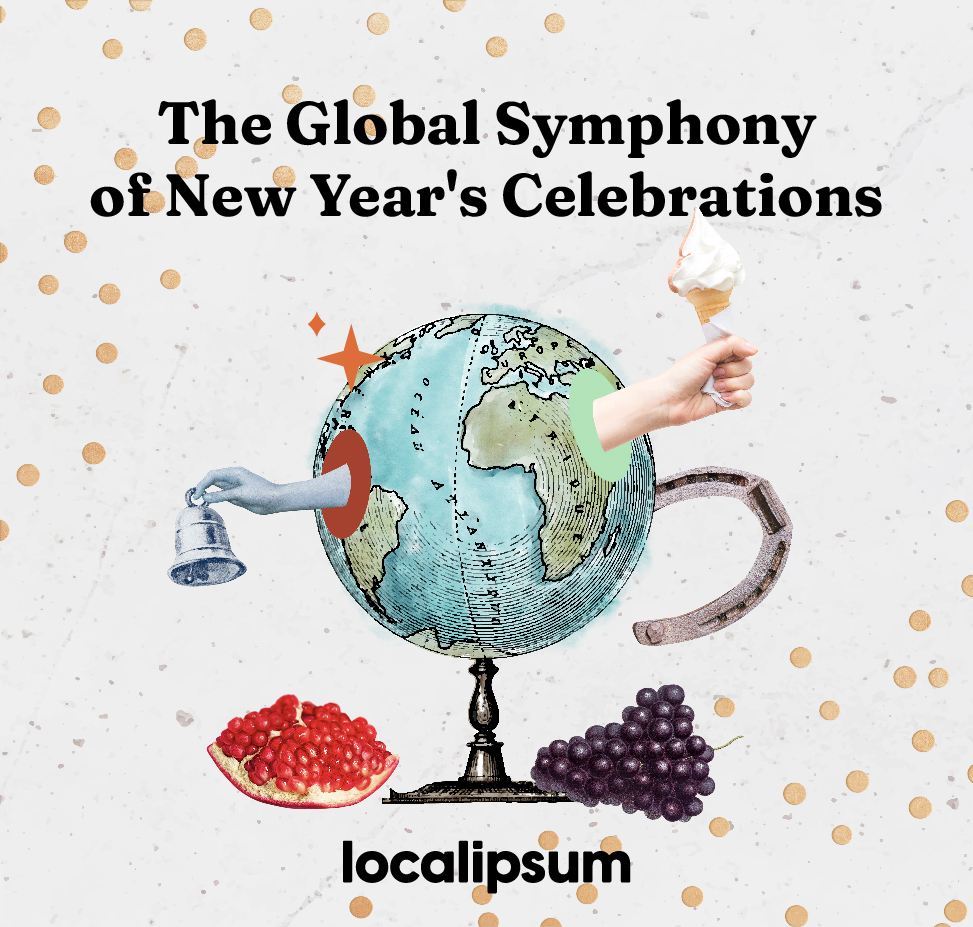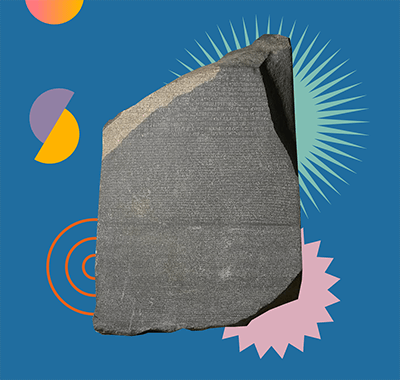Weird Traditions for a ‘Happy New Year’ – & Multiple Languages to Practice its Wishing
As the clock ticks towards midnight, a collective heartbeat echoes across the world, marking the anticipation of a new beginning. The celebration of the New Year is more than just a transition; it’s a global symphony, a harmonious convergence of diverse traditions and languages that paints the canvas of the human experience.
The phrase ‘Happy New Year’ acts as a linguistic bridge, connecting people from every corner of the world in a shared expression of joy, hope, and renewal – along with embracing the infinite possibilities of the future.
Each language carries its cadence, a unique melody that resonates with the cultural nuances of its speakers. Just like we did for Halloween, we decided to explore greetings and weird traditions that make New Year’s Eve a global celebration and, in some cases, an extraordinary spectacle.
Table of Contents
Spain - ¡Feliz año nuevo!
In the heart of Spain, the New Year’s Eve celebration takes a grappy-twist. Spaniards partake in a ritual that involves eating a dozen grapes in a precise and timely manner. The belief is that for each of the twelve strokes of midnight, one grape should find its way into your mouth, ushering in good luck and prosperity for each month of the coming year.
The roots of this tradition stretch back to 1909, a year marked by an exceptionally bountiful grape harvest. Seeking to capitalize on the surplus, producers ingeniously packaged grapes in sets of twelve, symbolizing the twelve months of the year. This innovative marketing tactic birthed the concept of “uvas de la suerte” or “lucky grapes”. Over the years, the tradition evolved, gaining layers of symbolism.
However, the origins may reach back even further. Newspapers from 1882 already documented mentions of this tradition. An alternate theory harks back to that year when the bourgeois Spanish class would indulge in champagne and grapes during their New Year’s Eve dinner. In an act of rebellion against class distinctions, a group of locals gathered at Puerta del Sol to bring “Grape Equality” to Spain by consuming one with each tolling of the bells.
Denmark - Godt nytår
Let’s go Nordic, shall we? In the heart of Denmark, quite a smashing tradition takes place. The Danish New Year’s Eve tradition of shattering plates against neighbors’ doors is more than just a spectacle – it’s a symbolic ritual that reflects the celebration of friendship, community, and the promise of good fortune in the days to come.
Just in case you’re left wondering… this is not a metaphor.
Picture this: as midnight approaches, Danes gather with a collection of unused dishes. What follows might be a bit on the wild side – but far from an act of aggression. The smashing of dishes is intended to leave behind any negative energies, paving the way for a fresh start in the New Year. Imagine gauging your popularity and level of positive vibes you’ll attract in the upcoming year by the height of the mountain of broken porcelain at your door on January 1st? Take that, you FB “
Japan - あけましておめでとう
From smashing to sacred. The night before New Year’s Day, named Ōmisoka in Japan, witnesses a sacred ceremony as temple bells across the nation ring out in unison during the ritual known as “Joya-no-kane.” These bells toll 108 times, each chime carrying a significant meaning deeply rooted in Buddhist traditions. Traditionally, monks perform this profound duty, yet in certain locations, everyday temple-goers are granted the honor of participating in the bell-ringing ritual.
The 108 tolls, deeply embedded in Buddhist significance, are believed to cleanse the hearts of listeners, purging them of the 108 human flaws and, in turn, alleviating the “four and eight forms of suffering” associated with Buddhist teachings. The ritual becomes a transformative journey, preparing individuals to embrace the new year with a purified spirit and a fresh start.
Scotland - Bliadhna mhath ùr
And now… a dip into eccentricity! In the frosty embrace of South Queensferry’s River Forth, Scotland, a Chilly-Willy tradition of New Year’s Day unfolds. “Loony Dook,” has become synonymous with the quirky Scottish spirit, offering a refreshing plunge into the icy waters to symbolize a spirited start to the new year. Bet you can’t take the image of Chilly-Willy out of your mind right now!
If you’re an adventurer at heart, ready to embrace the slightly mad and daring side of life, then Loony Dook on January 1st is tailor-made for you. Individuals adorned in eccentric costumes, gather for this celebration. The Firth of Forth in South Queensferry becomes the stage for this unique spectacle, where participants, fondly referred to as “Dookers,” enthusiastically embrace the cold waters. It’s more than a plunge; it’s a symbol of invigoration, a lighthearted way to welcome the beginning of the year.
The name itself is a delightful blend of “loony,” an abbreviation for “lunatic,” and “dook,” which means to “submerge” or “bathe” in Scots. Whether you decide to challenge yourself to dive into the icy waters or prefer to witness the extraordinary spectacle from the shores, the Loony Dook promises a memorable start to the year.
Now I have the battle of Chilly-Willy and Looney Tunes raging in my mind.
Czech Republic - Šťastný nový rok
Charming tradition takes center stage in Czechia – foretelling the future with the simple act of peeling and cutting an interesting protagonist: apples.
For the young and unmarried, the custom begins with the careful peeling of an apple in one unbroken strip. The twist comes as the peel is tossed over the shoulder, creating a dance in mid-air before landing. The shape it takes upon landing is more than a whimsical pattern: it’s believed to hold the key to the initial of their future spouse’s name or offer glimpses into the romantic destiny that awaits.
As the New Year’s Eve dinner concludes, families across the Czech Republic embrace a different tradition. Here’s how it unfolds: an apple is chosen, cut horizontally, and the pattern of seeds inside is revealed. A regular star suggests a year of good health and prosperity, while a cross forewarns of illness or, in more dire interpretations, death. If the apple harbors signs of internal decay, bad luck is said to be on the horizon. At Localipsum, we stick to grapes. We’d even dive into the Chilly-Willy waters as Looneys!
Greece - Eftychisméno to néo étos
What happens when you mix Czech and Danish NYE’s traditions? Well, you may obtain a Greek classic. Ladies and gentlemen, prepare your pomegranates, your deft hand, and let us begin.
At midnight, each member of a Greek household steps out into the night. One fortunate family member is chosen and tasked with a ritual known as the kalo podariko. Holding the pomegranate in hand, they swing it towards the front door with forceful vigor.
The burst of seeds becomes a spectacle of potential fortune: it symbolizes not just the redolent fertility and abundance associated with the fruit, but also serves as a shield, warding off malevolent spirits that may seek entrance into the home. Beyond the New Year’s ritual, Greeks exchange pomegranates as tokens of good luck, embedding these ruby-red gems with wishes for prosperity and positive beginnings.
Good friends also come around with some wet wipes the following morning. No, that’s not part of the tradition… it’s what our Chief Troublemaker would do to make up for all the troublemaking she did over the previous year… or a way to pay it forward for all she will do in the coming year!
Philippines - Maligayang bagong Taon
In the Philippines a delightful tradition unfolds, ushering in hopes of good fortune and a – juicy – year. This act involves the arrangement of 12 pieces of round fruit on dining tables, where each fruit becomes a symbol of wealth, signifying the promise of abundance throughout the upcoming year. The choice of the 12 fruits isn’t arbitrary; each piece becomes a beacon of wealth, representing the 12 months that will unfold in the coming year.
Beyond the numbers, certain rules govern the selection of these round ambassadors of luck. The fruit must be smooth, round, and bump-free when touched, signifying continuous fortune. Sour fruit, like lemons, are strictly off the table; sweetness is the key to a propitious New Year.
Brazil - Feliz ano novo
When it comes to welcoming a new year in style, no one does it quite like the spirited souls of Brazil. As the final moments of the year unfold, a sea of white-clad celebrants gathers in Rio de Janeiro at the Reveillon, ready to partake in a celebration that goes beyond the ordinary.
Wearing a white outfit is more than a fashion statement; it’s a symbol of purity and a fresh start. Even though it’s a practice spread throughout the entire country, it all starts with a celebration at Copacabana Beach where thousands of people pay homage to Iemajá, the goddess of the sea. The pièce de résistance of Reveillon is its breathtaking fireworks display. Approximately 25,000 tons of pyrotechnic wonders adorn rafts just off the coast, painting the night sky with a mesmerizing palette of light and color.
Finland - Hyvää uutta vuotta
A fortune-telling ceremony, horseshoes, and flames: what do these three have in common? Finnish New Year’s Eve, of course!
The process is as captivating as it is meaningful. Miniature tin horseshoes, symbols of potential and fortune, gracefully yield to the dance of fire. Melted in a pan and poured into a waiting basin of chilled water, the molten metal transforms, freezing into unpredictable shapes.
These forms, born in the alchemy of the moment, become vessels of prophecy. The interpretations are as diverse as the individuals themselves, each finding a personal narrative in the fluid contours of the cooled tin.
Switzerland - Frohes Neues Jahr
Fan of Swiss chocolates and treats? Well, then their traditions for NYEs will not disappoint! It involves more sugar than you might imagine.
Instead of the conventional countdowns and clinking glasses, the Swiss usher in the coming year with a delightful custom: dropping ice cream onto the floor. No need to double-check, you read right. And, well, yeah, you might be a tad disappointed it was not dropped in your mouth!
The Swiss strategically place ice cream on the floor, allowing it to make a sweet impact. The act is not a careless spill but a deliberate gesture, signifying the casting away of negative energies that might have lingered from the past year. It’s a ritual that transforms an ordinary act into a meaningful expression of leaving behind the old and embracing the new with a clean slate.
Cheers to a Year of Shared Celebrations
As we researched these customs around the globe, one common thread became abundantly clear – the intrinsic human desire for renewal, luck, and prosperity.
At Localipsum, where we celebrate the nuances of human communication, these traditions resonate deeply. Language, much like these customs, is a vessel for shared experiences and aspirations. It bridges cultures, connects hearts, and fosters understanding.
In the spirit of these diverse celebrations, we extend our best wishes to our beloved readers. May the coming year be adorned with the richness of shared stories, the warmth of human connection, and the prosperity that stems from understanding one another. As we navigate linguistic landscapes together, let us embrace the beauty of diversity – and the shared humanity that unites us all.


